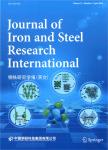Fluid Flow and Mixing in Non-Isothermal Water Model of Continuous Casting Tundish
Fluid Flow and Mixing in Non-Isothermal Water Model of Continuous Casting Tundish作者机构:Department of Materials EngineeringIsfahan University of Technology
出 版 物:《Journal of Iron and Steel Research International》 (JOURNAL OF IRON AND STEEL RESEARCH,INTERNATIONAL)
年 卷 期:2008年第15卷第2期
页 面:7-13,22页
核心收录:
学科分类:080503[工学-材料加工工程] 0806[工学-冶金工程] 08[工学] 0805[工学-材料科学与工程(可授工学、理学学位)] 0703[理学-化学] 0802[工学-机械工程] 0801[工学-力学(可授工学、理学学位)] 0702[理学-物理学] 080201[工学-机械制造及其自动化]
主 题:tundish non-isothermal condition mixing model water modeling
摘 要:Fluid flow and mixing of molten steel in a twin-slab-strand continuous casting tundish were investigated using a mixing model under non-isothermal *** model led to a set of ordinary differential equations that were solved with a Runge-Kutta *** state water modeling was carried out under non-isothermal *** data obtained from the water model were used to calibrate the mixing *** to the presence of a mixed convection in the non-isothermal conditions,a channelizing flow would be created in the fluid inside the tundish.A mixing model was designed that was capable of predicting RTD(residence time distribution)curves for different cases in non-isothermal *** relationship between RTD parameters and the Tu(tundish Richardson number)was obtained for various cases under non-isothermal *** results show that the RTD parameters were completely different under isothermal and non-isothermal *** comparison of the RTD curves between the isothermal and non-isothermal conditions presents that the extent of mixing in the tundish in non-isothermal conditions is lower than the mixing extent in isothermal conditions.



